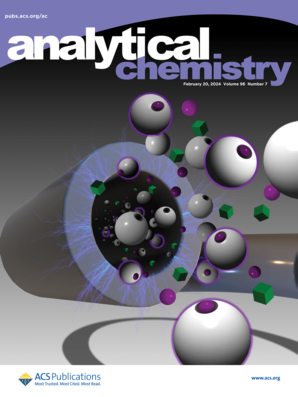基于脚本表达式的GC - x - GC -高分辨率TOF-MS在塑料热解油中的有机氯化物形态分析
IF 6.7
1区 化学
Q1 CHEMISTRY, ANALYTICAL
引用次数: 0
摘要
塑料热解油(PPO)中氯(Cl)的存在给塑料回收带来了环境和技术挑战,包括腐蚀、催化剂失活以及在PPO进一步加工过程中形成不需要的化合物。因此,确定和量化cl的种类对于实现PPO去污或避免这些分子在热解过程中形成至关重要。在此框架下,开发了一种非靶向筛选方法,并通过在碳氢化合物混合物中加入cl标准物进行验证,并通过综合二维气相色谱法和高分辨率飞行时间质谱法(GC × GC- hr - tofms)应用于PPO样品。首先,基于氯化同位素模式的精确质量差和丰度比,使用脚本表达式开发了三个过滤器。严格的过滤允许cl -物种检测没有任何假阳性,但排除了一些cl -物种。更广泛的过滤器可以识别更多的氯化物种,尽管它们也带来了相应的假阳性。其次,用光谱分析工具(SAT)处理GC × GC- hr - tofms数据,SAT是一个附加的工具包,与Leco chroof软件配对,有助于识别含氯的MS片段。事实证明,SAT在审查脚本表达式检测到的潜在cl物种列表方面特别有效,能够区分假阳性和氯化片段。用过滤器和SAT筛选cl -物种可以在一个真实的PPO样品中鉴定出24种有机氯。因此,应用所描述的方法改进了GC × GC- hr - tofms对PPO样品的分析,使分析过程更快、更强大。本文章由计算机程序翻译,如有差异,请以英文原文为准。

Organochloride Speciation in Plastic Pyrolysis Oil by GC × GC Coupled to High-Resolution TOF-MS Using Scripting Expressions
The presence of chlorine (Cl) species in plastic pyrolysis oil (PPO) poses environmental and technical challenges for plastic recycling, including corrosion, catalyst deactivation, and the formation of undesired compounds during further processing of PPOs. Therefore, identifying and quantifying Cl-species is crucial to achieve PPO decontamination or avoid forming these molecules during the pyrolysis process. In this framework, a nontargeted screening methodology was developed, validated with Cl-standards spiked in a hydrocarbon mixture, and applied to a PPO sample by using comprehensive two-dimensional gas chromatography coupled with high-resolution time-of-flight mass spectrometry (GC × GC-HR-TOFMS). First, three filters were developed using scripting expressions based on exact mass differences and abundance ratios of chlorinated isotopic patterns. A strict filter permitted Cl-species detection without any false positives, but excluded a few Cl-species. Broader filters allowed the identification of additional chlorinated species, although they also brought a consequent number of false positives. Second, GC × GC-HR-TOFMS data were processed with the spectral analysis tools (SAT), an additional toolkit paired with the Leco ChromaTOF software, which helped identify MS fragments containing chlorine. SAT proved to be particularly effective in reviewing the list of potential Cl-species detected by the scripting expressions, enabling the distinction between false positives and chlorinated fragments. Screening Cl-species with filters and SAT allowed the identification of 24 organochlorides in a real PPO sample. Therefore, applying the described methodology has improved the analysis of PPO samples using GC × GC-HR-TOFMS, making the process faster and more powerful.
求助全文
通过发布文献求助,成功后即可免费获取论文全文。
去求助
来源期刊

Analytical Chemistry
化学-分析化学
CiteScore
12.10
自引率
12.20%
发文量
1949
审稿时长
1.4 months
期刊介绍:
Analytical Chemistry, a peer-reviewed research journal, focuses on disseminating new and original knowledge across all branches of analytical chemistry. Fundamental articles may explore general principles of chemical measurement science and need not directly address existing or potential analytical methodology. They can be entirely theoretical or report experimental results. Contributions may cover various phases of analytical operations, including sampling, bioanalysis, electrochemistry, mass spectrometry, microscale and nanoscale systems, environmental analysis, separations, spectroscopy, chemical reactions and selectivity, instrumentation, imaging, surface analysis, and data processing. Papers discussing known analytical methods should present a significant, original application of the method, a notable improvement, or results on an important analyte.
 求助内容:
求助内容: 应助结果提醒方式:
应助结果提醒方式:


